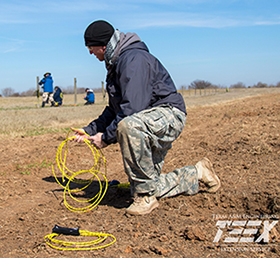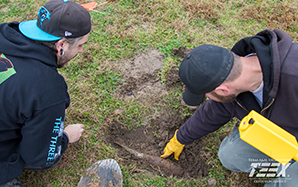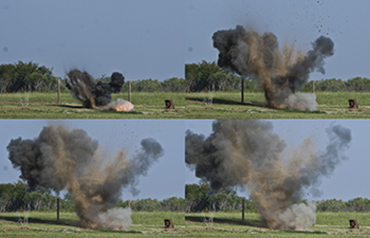BRYAN, TEXAS – In 1999, the Texas A&M Engineering Extension Service (TEEX) became the first to offer Unexploded Ordnance (UXO) Technician I training for civilians. The entry-level workers would supplement the workforce of retired military EOD (Explosives Ordnance Disposal) Technicians tackling the massive cleanup and remediation of thousands of acres of former military installations closed in the 1990s.
This pioneering decision was recently recognized by a proclamation from Gov. Greg Abbott in honor of the 20th anniversary of the program, which has trained over 1,100 UXO Technicians.

The impetus for the program was an agreement in the 1990s between the U.S. Department of Defense and the Oglala Sioux Tribe at Pine Ridge Reservation, SD, to provide training so they could participate in the remediation of the Badlands Bombing Range.
Col. Paul Ihrke, who was the Army Staff Representative on the DoD Explosives Safety Board at the time, was tasked with finding a way to provide the training. He developed a plan and preliminary curriculum, but he had no success in finding a training provider until he made a fortuitous trip to College Station, TX. Ihrke, a Texas A&M graduate, asked a university official if there was anyone in The Texas A&M University System that conducted hazardous materials training, and he was referred to TEEX.
Former TEEX Associate Director Bob Prock was excited about the potential. “It seemed like a perfect fit,” Ihrke recalls. Shortly afterward, Ihrke retired from the Army and went to work for a UXO start-up company owned by Ash Sudhakar. On another trip to College Station in January 1997, Prock showed him around the Texas A&M Riverside Campus (now RELLIS), where there was land available to set up a search grid and demolition range.
TEEX and Sudhakar signed a Memorandum of Agreement to jointly conduct the training. Next, Ihrke recruited Rex Shipp, a former instructor at the Navy’s EOD (Explosive Ordnance Disposal) School to refine the curriculum and assist with designing and constructing the training grounds.
For the next two years, Ihrke and Shipp worked on the curriculum, while obtaining training aids and seeking DoD and Texas A&M University System approval. “It was important to make sure we had good training aids,” Ihrke says. “We wanted to give the students an opportunity to train on just about any munition or ordnance they would encounter in the real world.”

With his Army contacts, Ihrke was able to obtain tons of inactive munitions and training ordnance through an agreement with the Army Reserve Center in Bryan. With the inert bombs, missiles, grenades and projectiles, they were ready to bury ordnance and set up the search grid.
Soon Ihrke contacted the Oglala Sioux at Pine Ridge to set up the first class, which was led by Shipp and a team of instructors in February 1999. Initial classroom training was offered in Cedar Rapids, SD, and then the students came to TEEX for hands-on training on the newly constructed search grid and demo range. The graduation ceremony was held at the Pine Ridge Reservation.
Two DoD representatives observed the first class and evaluated the program, which received approval shortly afterward, making it the only civilian UXO Technician program to have ever received DoD approval. The National Association of Ordnance Contractors (NAOC) also recognizes the course as meeting and exceeding UXO Tech I training requirements.
Other UXO Technician programs began cropping up as more military base closures occurred and more bombing ranges needed remediation, but “no one could match us in terms of facilities and training aids,” Ihrke says. He went to national conferences and began recruiting additional students for the program. One roadblock was the ability of a UXO Tech I to work on Corps of Engineers remediation sites, but once that roadblock was removed, jobs were plentiful in the early 2000s, Ihrke recalls. In 2002, TEEX purchased the program, but Ihrke remains a part-time instructor for the course.

Meanwhile, Ed Fritz was working at the U.S. Navy EOD School when he learned about the UXO Program at TEEX. After retiring from the military, he joined TEEX, and in 2004, he began leading the UXO Tech I program.
In 2008, the UXO Program added training in HAZWOPR for Clean-Up Operations, Heavy Equipment Operator for Ordnance Workers and Humanitarian Demining. A certificate program – Ordnance Removal and Remediation Technician – was added. The program also got approval for VA Education benefits, and became the only UXO Technician school recognized by the Canadian government.
Today the Explosives and Ordnance Training Program, part of TEEX’s Institute for Law Enforcement and Protective Services Excellence, has evolved to include training on ordnance recognition and safety for first responders. In 2006, a police bomb squad member in California heard about the UXO program and requested a customized class, to include recognition of homemade bombs, not just military ordnance, along with safety and disposal procedures.
This led to a new course, Advanced Ordnance Recognition for Law Enforcement (AORLE). The two-week program is popular with bomb squads assigned to police departments, as well as bomb technicians with the Bureau of Alcohol, Tobacco, Firearms and Explosives (ATF) and the FBI. The course has been offered across the nation, with classes for the New Jersey State Police, and police departments in Los Angeles, Philadelphia, Phoenix, Chicago and more, said Fritz. Explosive Breacher Entry training for law enforcement officers was also added to the course catalog.
An additional program was established in 2017, after another fortuitous visit to Texas A&M by Brian Cracchiola, manager of the High Explosives Applications Facility at Lawrence Livermore National Laboratory in California. Cracchiola learned that TEEX offered an explosives course while visiting his daughter, who was a student at Texas A&M. He was seeking a training provider to standardize training for explosives handlers at Lawrence Livermore, so he worked with TEEX and the Department of Energy to establish an Explosives Handler Training program. Through the program, LLNL employees complete 40 hours of online training, and then come to TEEX for two weeks of face-to-face and hands-on exercises. This includes experience handling live explosives on the demo range.
Fritz says the Explosives and Ordnance Training Program will continue to expand into new areas of explosives training, adding: “I’m just proud to be a part of it all.”
Learn more about TEEX Explosives & Ordnance Training.
